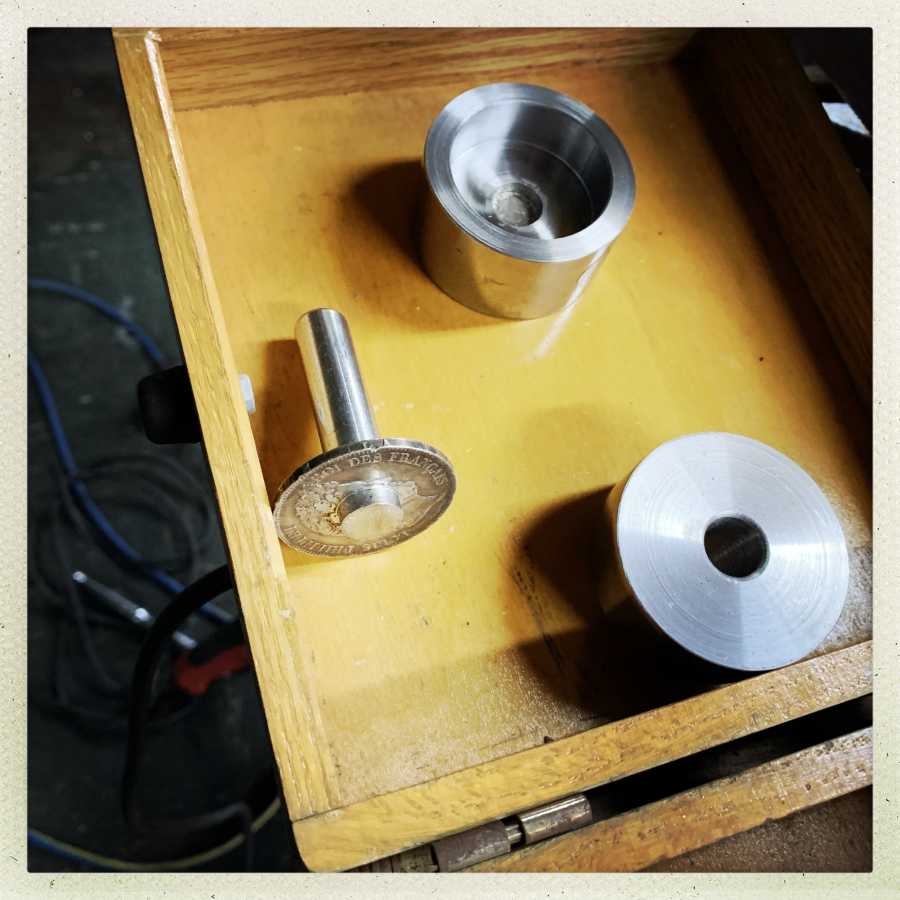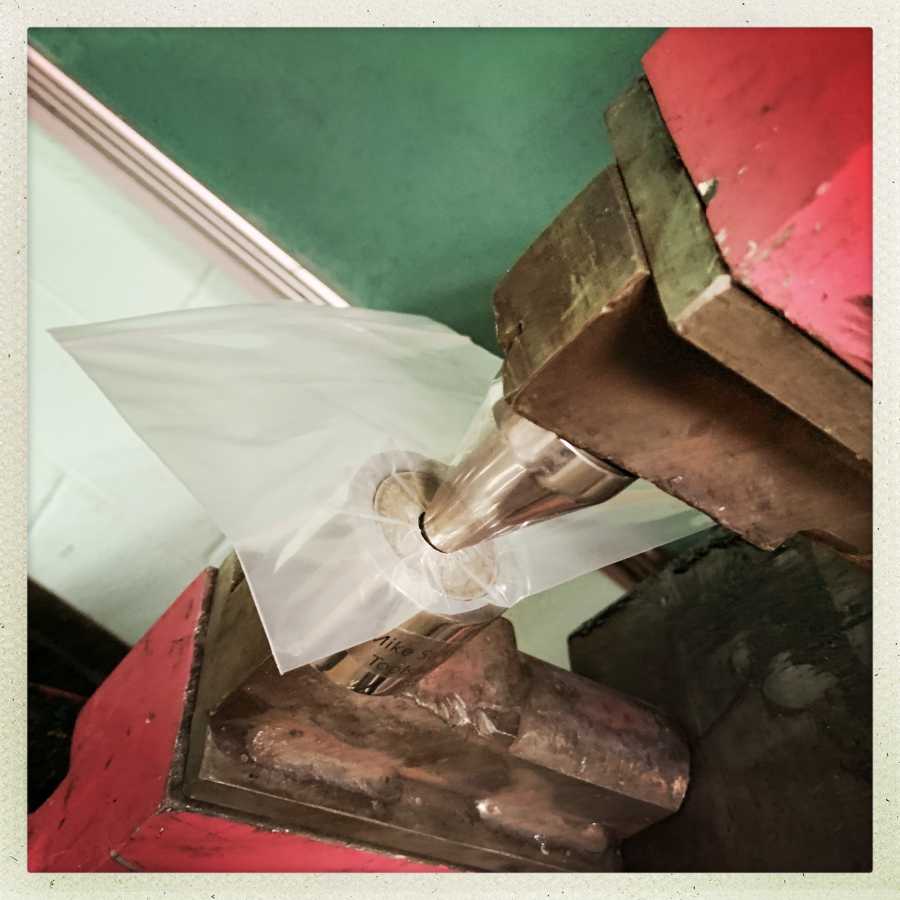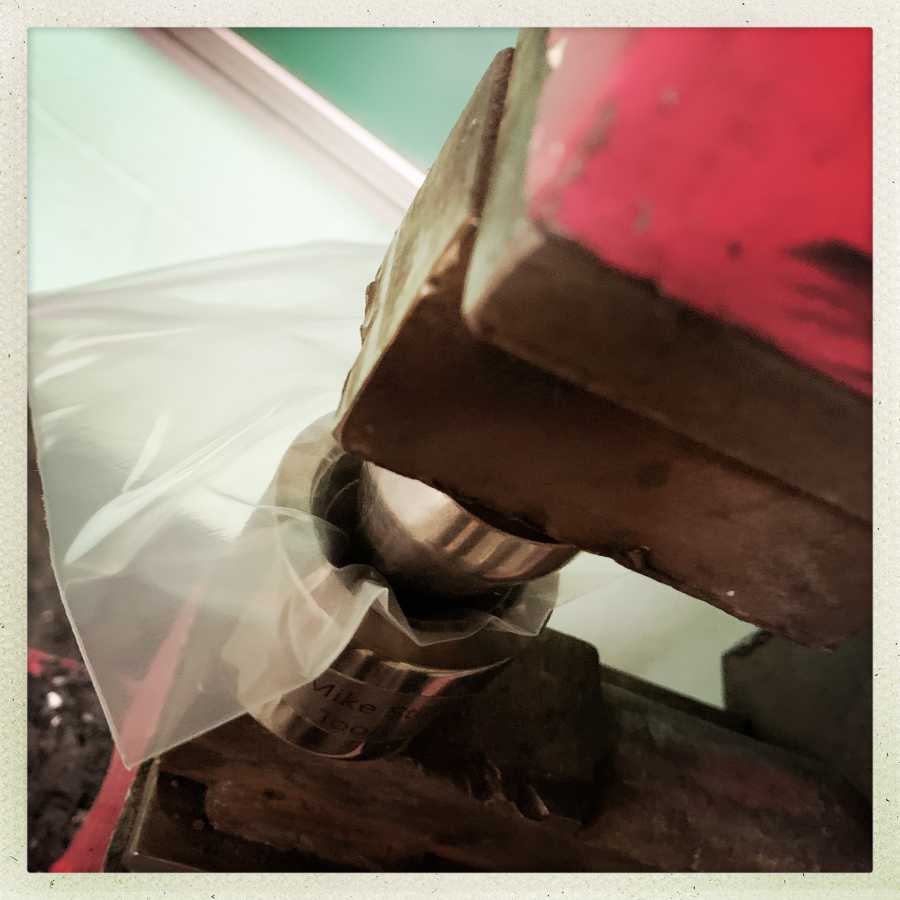I had managed to forget that silver work hardens. To soften silver you heat it to red heat (which is just below its melting temperature) and dunk it in cold water. This is exactly the opposite process for hardening steel.
It doesn’t take much to work harden silver, especially if you’re grinding on it, because it heats up quickly.

1930s silver French coin with Louis Phillipe on the front. I’m not fond of monarchs and nobles, so I thought he could use a punch in the face. The punch/die worked like a charm: I lined the coin up in the punch holder, put the punch in, and put it in the press, then gave it a little bloop of power. Bam! Instant hole!
Step 1 accomplished!

Most of the people who do these use teflon tape wrapped around the coin, to make it slip into the die better. I used heavy duty poly plastic baggie, instead. For one thing, I was wondering if bits of metal might go flying around, in which case a baggie seemed like a natural idea. I adjusted the position of all the stuff before I applied power to it; it occurred o me that careful positioning might be critical.
Step 2 ready to go!

A little tug on the down lever engages the hydraulics. The coin offers no resistance at all – the Pink Press just shoves the die right down and something has definitely happened. But, what?

Step 3: Fail!
A few things are worth noting. The poly bag appears to have done a good job of protecting the detail in the metal. The inner surface of the press tool and die were unmarked, which is good. I was afraid I might get too enthusiastic with the press and pressure a ring into the press tool. But, it blew the coin apart. There are a few possibilities: the French government debased their coinage and started using something more fragile than silver with a hint of tin. Or the old coin was work hardened from being bling blinged and dropped and passed around for decades. If I had annealed it, would it have been more pliable?
I’m not deterred. The coin of Louis Philippe will make a silver trinket and it’ll be better than Louis Philippe was as a monarch. I have a few Japanese coins coming and somewhere I have some Tibetan coins that (I believe) are silver. I’m going to see if I can rummage them up.
For now, I am marking this technique as “not as easy as I thought” and I’ll do a bit more research.

Wouldn’t a coined coin be pretty well work hardened already? I can’t see what a final annealing step would add to the coining process.
Yeah, you could try annealing the coin first. My thought too was to try doing it in two stages, if that’s possible. Maybe try punching it half the way, anneal again, and then finish it.
Or, you could try using a hammer instead of a hydraulic press, and just use little taps to ease it into the shape you want. Again, you might have to stop and anneal it.
It’s a good start though! Poor coin, it survived all those years only to come to the US and get smashed to pieces.
@davex, #1: the idea is not to make it harder. In this case the annealing will make it softer, or at least more flexible.
@kestrel #3; I understand. My Q was about the state of the coin pre-“step 1”. I think the coining process would do more work hardening than the handling in circulation. Work-hardened material, from whichever cause, coming into step 1 might be better for punching than softer, gummier annealed metal, and a clean punch wouldn’t deform the surrounding metal much, thereby not adding much to the work hardening.
I don’t think it was work hardening in step 1 that made the coin rip in step 2.
I forgot how coins are made; that would definitely do more than “work harden” the silver.
The real question, to me, is whether annealing it will help, or maybe I need to use something less crumbly than silver. Copper/nickel sandwiches like US quarters ought to be tough. I also wonder if I could just punch the centers out of EU money, the ones with bi-metal centers.
huh. I watched that youtube vid that you linked on a previous post, and they mentioned silver getting work-hardened, which was something I didn’t realize happened (I mean, I’ve heard about it for various steel alloys, but sorta thought silver was soft enough to not matter?), let alone that it would be mitigated by a hot quench… what happens when silver is left to cool slowly, like how steel is annealed?
At risk of siccing the secret service and other anti-counterfeiting organizations on me…
you seem to be pretty good at getting some high-detail molds/reproductions done, is there a reason for not trying this with various coins? (I guess authenticity is it’s own nebulous status/goal) At least then, if something doesn’t work out, you can just throw it back into the “to be melted down” pile/bin…
horrible tangent, but I’m also reminded of some website back in the aughts or so, that was documenting attempts to cast a functional “silver bullet” for, like, werewolves or something…
@lochaber: if you let silver cool slowly, it hardens. It’s like steel only 180-degree opposite.
I tried to cast a few collars using lost wax but because I don’t have a vacuum rig set up yet, I could not get clean castings. Perhaps someday!
I have done a few wrap collars that look pretty snazzy. I’m also geared up to machine them on the metal lathe, except I need to move my forge and anvil and install and level the lathe, first. So there are months of work before I have the lathe in operation. When I do, though, I can be the “ferrule king” so long as I want them to all be round.
I think annealing would help, but my limited experience was a small bit of engineering the swaging of copper and rings onto projectiles.
Googling a bit I see http://www.michaelmccrory.com/deep-drawing — After looking at silver flow in the those videos, maybe your issue isn’t the temper, but the alloy.